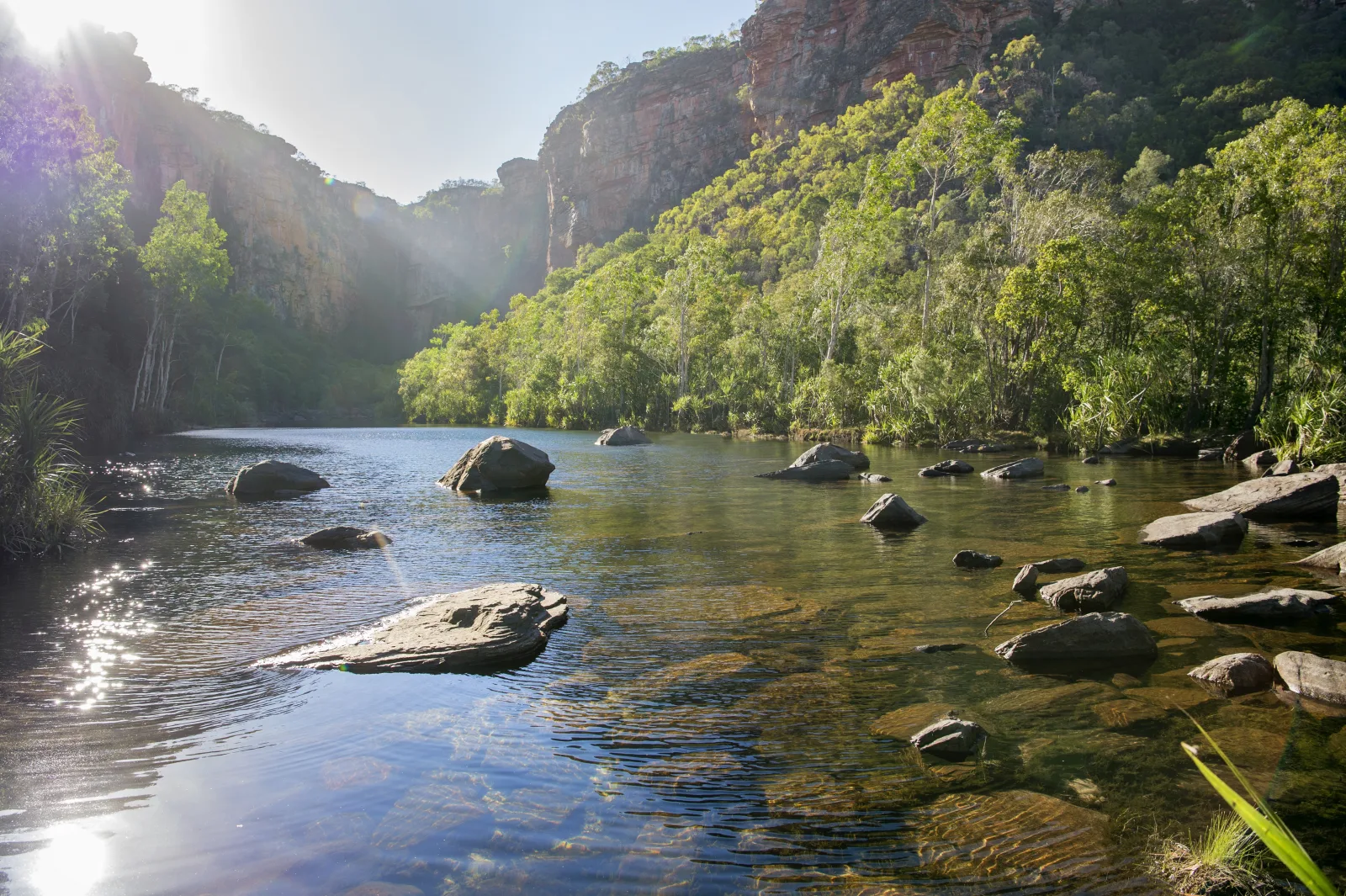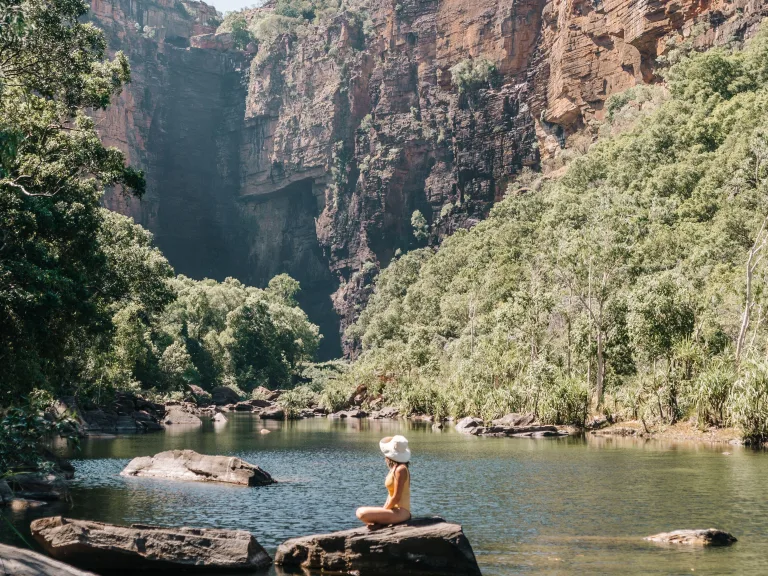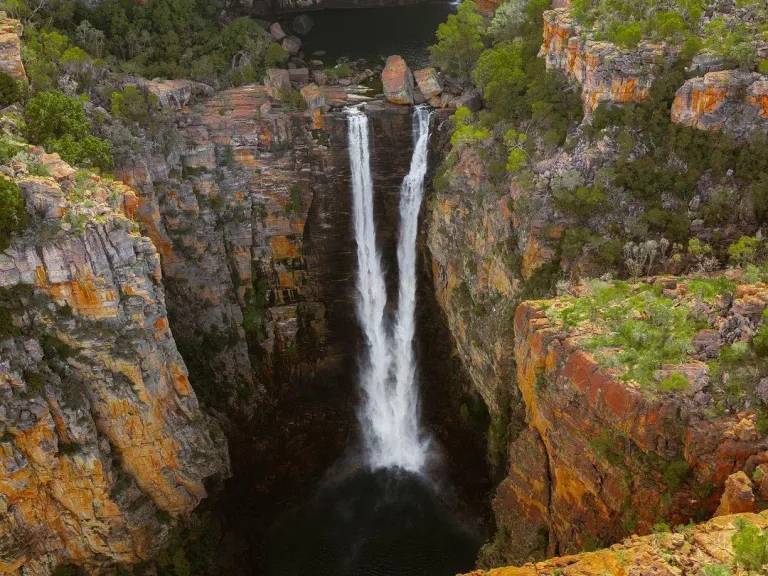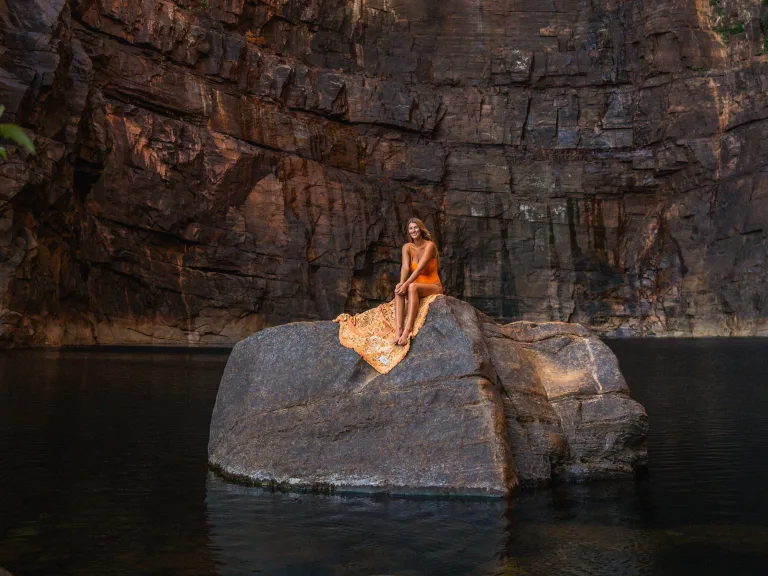Jim Jim Falls
- Home
- See & Do
- Attractions
- Jim Jim Falls
Jim Jim Falls is an Iconic Natural Wonder of Kakadu
Officially Open from 6:30am Saturday, 12th July 2025!
Jim Jim Falls, one of Kakadu’s most powerful waterfalls, plunges 200 metres from the Arnhem Land escarpment into a deep plunge pool below. Reaching it requires a 2km walk through sandy and rocky terrain—perfect for adventurous travellers with a 4WD. In the dry season, enjoy a swim beneath towering cliffs; in the wet, witness the falls in full force from a scenic flight. Nearest services are at Cooinda Lodge (1.5 hours away), so come prepared with essentials like water, food, walking shoes, sunscreen, and insect repellent.
CHECK ACCESS report
Jim Jim Falls is one of Kakadu’s most iconic destinations. In the wet season, the only way to witness its full power is from the air—an aerial tour over Jim Jim and neighbouring Twin Falls is a bucket-list experience. The sheer force of water thundering over the escarpment and the mist rising high into the sky is nothing short of awe-inspiring.
While road access is nearly impossible during the wet, usually from July through to September, adventurous travellers can tackle a well-maintained 50 km 4WD track. Just 900 metres from the car park lies a spectacular reward—an outback oasis waiting to be discovered.

It’s always intriguing to learn how some of Kakadu’s iconic landmarks got their names—especially those given by Europeans drawing from local Aboriginal language. Jim Jim derives from andjimdjim, the name for the native water pandanus that grow along the creek leading to the falls.
The walk to the plunge pools is short but can involve a bit of rock scrambling. Along the way, you’ll pass through a majestic anbinik forest, where towering trees offer welcome shade, even during the heat of the day. These ancient giants are the largest trees found in the escarpment country and are among the world’s oldest living plant species—dating back more than 400 million years.
Keep an eagle eye out for eagles and falcons, but also rainbow bee-eaters and the striated pardalote bird, which you might be able to spot in the canopies of the trees. The walk does mean some scrambling over boulders, but you’ll get to see water monitors sun-baking on a boulder after chasing their lunch through the clear water of Jim Jim Creek.
Importantly, Kakadu National Park rangers clear the area of any potential crocodiles after the wet season, which is why you generally can’t swim until June/July. The Bowali Visitor Information Centre can always provide an update, or head to the online Parks Access Report which is updated daily.
So what’s all the fuss about?
After the walk, a massive rock pool – possibly 300 metre diameter – awaits, surrounded by towering cliffs and sandy beaches carved out over millions of years. While the waterfall diminishes to a trickle during the dry, it feeds a glorious swimming hole that teems with fish. Make sure you bring a snorkel or goggles to view the fish below. In fact, bring a picnic hamper and spend a lazy morning and afternoon there.
The drive to Jim Jim falls is just over an hour from Cooinda, and 90 minutes from Jabiru. You will need a high clearance 4WD, and the road can become corrugated towards the end of the dry season, but after a whole lotta shakin’ going on, the end result will be worth every jolt!

Optional Barrk Marlam Walk (7km)
For the more adventurous, the Barrk Marlam walk is a 7 km return rugged ascent to the top of the escarpment above Jim Jim Falls. The views are spectacular, but the walk is only for those who are experienced and fit – and best done early morning, as the return trip can take between four and six hours, depending on your fitness level.
The Baark Marlam walk branches off from the Jim Jim Falls plunge pool track. You walk through the rugged stone country typical of the Arnhem Land plateau, and if you keep a sharp eye out, you will discover why it is named ‘Baark’, because that’s the local name for the black wallaroo, a small wallaby-sized macropod only found in Kakadu.
Start Your Journey Here!
Getting to Jim Jim Falls
From Darwin to Jim Jim Falls
-
Distance: Approx. 430 km (6–7 hours total drive time)
-
Directions:
-
Take the Stuart Highway south from Darwin.
-
Turn left onto the Arnhem Highway and follow it to Jabiru (approx. 3.5–4 hours).
-
From Jabiru, continue on the Kakadu Highway and then follow signs to Jim Jim Falls Road.
-
The final 60 km is 4WD-only and includes corrugated roads, soft sand, and creek crossings.
-
-
Note: Always check the Kakadu National Park Access Report before setting out, as Jim Jim is seasonally accessible (usually June–October).
From Jabiru to Jim Jim Falls
-
Distance: Approx. 90 km (2 hours each way)
-
Directions:
-
Head south on the Kakadu Highway for about 43 km.
-
Turn left onto Jim Jim Falls Road.
-
Drive approximately 50 km on a high-clearance 4WD-only track to the car park.
-
-
Note: Allow extra time for the slow-going 4WD track, especially later in the season when roads can be rough.
From Cooinda Lodge to Jim Jim Falls
-
Distance: Approx. 65 km (1–1.5 hours each way)
-
Directions:
-
Head north on the Kakadu Highway for about 13 km.
-
Turn right onto Jim Jim Falls Road.
-
Follow the 4WD track to the Jim Jim car park (approx. 50 km).
-
-
Note: Be sure to bring plenty of water, recovery gear, and check current conditions before heading out.
Final Access to the Falls
-
From the car park, it's a 2 km return walk to the plunge pool.
-
The trail includes sand, rocks, and boulder scrambling, so good footwear and moderate fitness are recommended.

Tours from Darwin
Group Tours: A wide range of day trips and multi-day adventures to Kakadu depart from Darwin. Visit our Tours page to explore your options.
Private Tours: For a personalised experience, book a private day or multi-day tour with operators like NT Driver Guide and others.

Book a Tour to Jim Jim Falls:

Never Never Safari Tours: Full Day Jim Jim
Available from July 2025 — Subject to seasonal site closures.
Explore Kakadu's stunning landscapes with our friendly guides on an 8-hour tour. Discover rugged cliffs, lush rainforests, and a seasonal waterfall, while learning about local flora, fauna, and Aboriginal culture. Suitable for ages 3–100, with small groups (2–18). Meeting points: Jabiru and Cooinda lodges.

Kakadu Air Scenic Flight
Available year round — best views of Jim Jim over wet season!
Discover the Northern Territory's changing beauty with Kakadu Air. In the wet season (November to April), heavy rains transform the landscape, filling rivers and creating lush vegetation. Waterfalls flow, and the park becomes vibrant. In contrast, the Dry season (May to October) unveils a different scene with clear skies and thriving wildlife. Kakadu Air invites you to experience both seasons from the air, offering a memorable journey through the extraordinary wilderness of the Northern Territory, capturing its unique charm in both wet and dry conditions.










